One of the universal misconceptions about World War One on the parts of its combatants was how long it was expected to last. When war broke out, the prevailing assumption on all sides was that the conflict would be short – troops would all be home by Christmas of 1914. The meat grinder of trench warfare stalemate was not anticipated, nor the horrific toll such warfare would take on the men and armies participating.
The euphemistic term for men and equipment being blown into unrecognizable pieces was “wastage” – and even as early as the autumn of 1914 wastage was consuming as many as 40,000 rifles per month. This led to a huge pressure to equip soldiers on the front lines, with a combination of a growing army as more troops were recruited and conscripted and the loss of rifles to combat. The primary rifle of the French army at this time was the M1886 R93 Lebel, which was a reasonably expensive and time-consuming weapon to produce. Not really a big deal during peacetime, but the sudden demand for rifles far outpaced production capacity. So while that production capacity was increased, other solutions had to be found.
One major solution was to take away the Lebel rifles from troops who didn’t really need the best weaponry (POW camp guards, drivers, some artillery crews, etc), give them a substitute rifle, and send their nice new Lebels to the front. Of course, you would ideally want those substitute rifles to use the same standard 8x50R ammunition as the Lebel. Two of the most common solutions were the Remington Rolling Block and the Mle 1874 Gras.
Mle 1914 Remington Rolling Block
France (along with dozens of other nations) had issued Remington Rolling Block rifles in the late 1800s, when the RRB was one of the most prolific military rifles on the planet. As a single-shot black powder rifle, they had few major competitors on the commercial market. Well, in 1914 the arms production capacity of the Remington company was available to anyone with money. The Rolling Block was obsolete by this time (Remington had ceased production of all but the rimfire models), but the tooling was still there and the design remained inexpensive, robust, and reliable. In November 1914 the French government placed an order for 100,000 of the rifles (including some carbines) in 8mm Lebel, with wooden upper handguards and bayonets.
These would prove to be the only single-shot rifles manufactured new for use in the Great War. The first deliveries began in March 1915, and by June of that year Remington was producing 500 per day. The entire contract was delivered on schedule by early 1916. These Remington rifles were marked a bit differently than typical French-production military arms. They were serial numbered on the stock and the barrel only (and this was done upon receipt in France, not by Remington), and some inspections like confirming parts interchangeability with other manufacturers was skipped (since Remington was the only manufacturer). The one identifying mark from Remington (aside from the patents marked on the tang) was “CAL 8MM” stamped on the barrels. These were the only smokeless-powder 8mm Rolling Blocks made, and thus are fairly easy to identify upon inspection.
The bayonets provided had 405mm blades per French requirement, but were otherwise basically identical to the bayonets Remington had manufactured for military Rolling Block contracts in past decades. After the end of WWI, the Rolling Blocks remained in inventory, and some – including the one photographed below – remained there at least into the 1930s, as evidenced by it’s “N” chamber conversion.
Mle 1914 Remington Rolling Block in 8mm Lebel:
Mle 1874 M14 Gras
Another major source of substitute standard rifles for the French early in the war was the conversion of 1874 Gras rifles. Originally chambered for the 11x59mm black powder cartridge, there were a lot of Gras rifles sitting in inventory in 1914. In order to modernize them for the 8mm Lebel cartridge, a somewhat unusual plan was devised. Rather than bore out and sleeve the existing barrels, brand new Lebel barrels and sights were fitted to the Gras receivers. Presumably the barrel production capacity for the Lebel exceeded the overall rifle capacity, and excess barrels could be siphoned off to projects like these conversions with impacting overall rifle production.
One consequence of using Lebel barrels, however, was that they had a significantly smaller outside diameter than the original 11mm barrels. This meant that pieces like the front barrel band would not fit without modification. The solution to this problem was to cut off the front few inches of the old 11mm barrels, bore them out, and fit them over the new Lebel barrel. This allowed the front band and the front end of the stock to fit as originally designed, and it also meant that the front sight and bayonet lug from the Gras could be reused, reducing production costs (and allowing the use of existing Gras bayonets rather than requiring additional new Lebel bayonets).
Some of the Gras rifles in inventory were in fact conversions from the even earlier Mle 1866 Chassepot needle rifle, and so 8mm conversions can be found marked both as Mle 1874 and as Mle 1866-74. Virtually all of these rifles would have been updated to the 1880 pattern (which improved gas venting, among other things), and will thus also be marked “M80” on the right side of the receiver. The 8mm conversions can be identified by an additional “M14” stamp on the left of the receiver as well as the use of the Lebel style rear sight and a wooden upper handguard.
As with the Rolling Blocks above, M14 Gras rifles were put into storage at the end of the war and some remained at least into the 1930s. The one pictured below has been converted to the “N” chamber in the 1930s, and also painted with black enamel (another 1930s practice).
It should be noted that while the Rolling Blocks were designed from specifically for smokeless powder modern cartridges, the Gras is a single locking lug design not intended to high pressure ammunition. It was deemed safe enough by the French, but present-day collectors and shooters would probably be well advised to inspect them carefully prior to fiting, and consider using only light handloads – or not shooting them at all. Definitely don’t use surplus Balle N machine gun ammunition.
Mle. 1874 Gras converted to 8mm Lebel:






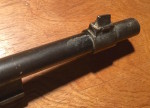


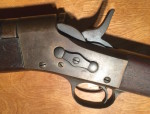







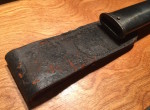

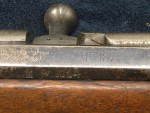
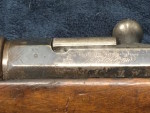
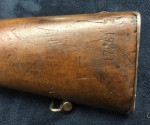








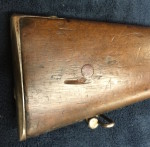






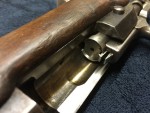
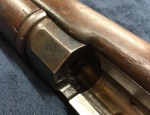
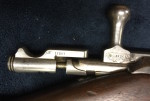
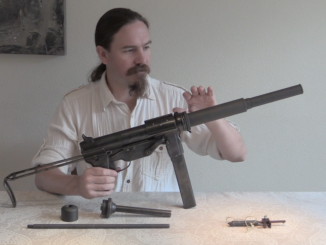
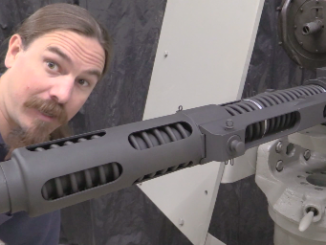
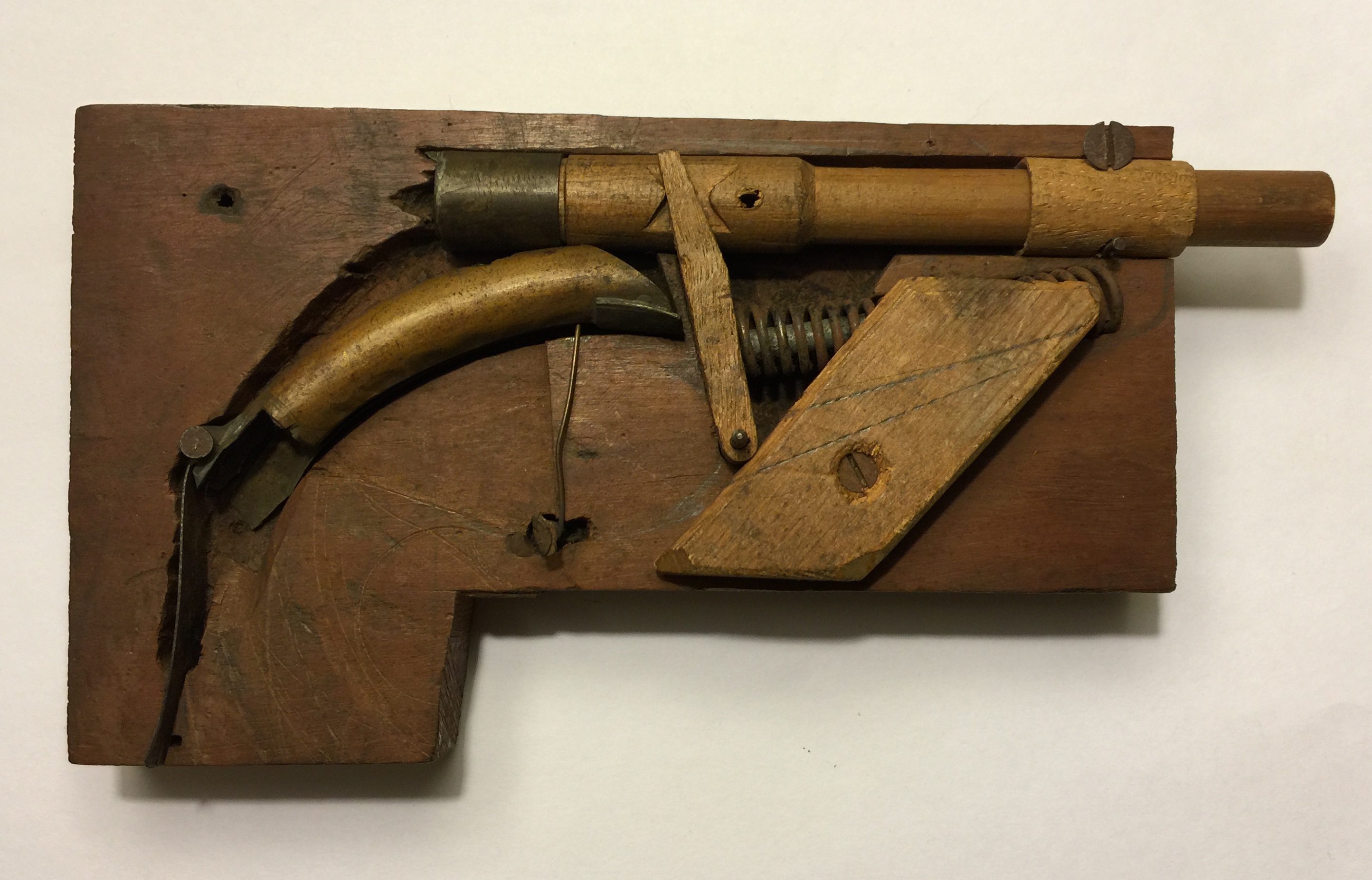
Do you know where these rifles were sold when surplused by the French? To their overseas colonies, arms dealers, or other? Also the ones pictured…are they in the US?
Over the past decade or so I’ve seen several of the rollingblocks come up for sale in the US so at least some were likely sold as surplus here.
Doby,
The vast majority of these when surplused were sent to their overseas colonies and others sold to the U.S. Market.
I know during WWII many Mle.1873 M.14 ‘Gras’ were still being used by the French Air Force Security Teams, somewhere I have a picture of an airman standing guard with one in front of a French bomber.
The 15th annual Shotgun News Treasury (still on the newsstands right now) has a two-part article on “French Rifles of World War 1” by Paul Scarlata. Part 2 covers the “substitute standard” rifles, in 8mm and otherwise.
The Gras in both rifle (“Fusil d’Infanterie Modele 1874 M’80”) and artillery carbine (“Mousqueton d’Artillerie Modele 1874 M’80”) persuasions, was issued in 11 x 59R in addition to 8mm Balle D. The 11mms went to support troops behind the lines, as well as “anti-balloon” AA gun units. These were equipped with Hotchkiss heavy MGs or British-made Vickers HMGs chambered for the 11 x 59 round (and firing API bullets), so giving them rifles in the same chambering made sense. Although I’d be very hesitant to fire the powerful, smokeless-powder Vickers variant of the 11 x 59 in any Gras.
Regarding the Remington Rolling Block, according to the article the band-mounted front sight on the Remington Modele 1915 in 8mm Lebel was unique to that variant. It would be fast way to identify one sitting in a rifle rack with other RRBs, I’d imagine.
The Modele 1915 also wasn’t the only smokeless-powder version of the RRB. Going back to the 1890s, Remington made the rolling-block in 7 x 57 Mauser for armies such as Mexico’s, which used the M1893 Mauser in that chambering as their standard rifle, and wanted a cheaper single-shot in the same chambering for reserves, etc.
The French bought a large number of such 7 x 57 RRBs in late 1914, referring to them as the “Remington Modele 1902” in both rifle and carbine persuasions.
The carbine version, intended originally for cavalry use, has the classic carbine-type “bar and ring” on the left side of the receiver for attachment to a saddle harness, and is half-stocked like the old U.S. Springfield “Trapdoor” cavalry carbine in .45-70, of Custer (in)fame.
The M1902 7 x 57 rifle is externally largely indistinguishable from the M1915 8mm version, other than having the “regular” RRB front sight on the barrel rather than the “banded” one seen here. So a “small-bore” (.30 cal. or so) RRB with French markings could be either an 8mm or a 7 x 57.
It would be interesting to check a 7 x 57 Modele 1902 to see what national crest it has over the chamber, in addition to its French acceptance marks.
For that matter, wasn’t the RRB made in .30 Govt (Krag) as well? The article states that the French bought reconditioned (ex-Cuban Guardia Civil) Remington-Lee M1899 magazine rifles from Remington in .30-40 Krag along with the 7 x 57 RRBs. (The GC had been re-equipped with actual Krag M1892s in 1912; I suspect they’d have been wiser to stick to the stronger and higher-firepower Remingtons.)
I’m wondering if there might not have been some .30-40 rolling blocks in that lot, as well.
cheers
eon
Eon,
Do you know if any of these substitute rifles were ever used in combat?
The article says that the Gras 8mms were issued to; reserve, territorial, and transportation units, plus the customs department, border guards, and training units. Also, “many” colonial units in Africa and Indochina traded their Lebels and Berthiers for Gras single-shots so the 8mm repeaters cold be sent to Flanders.
The Remington rolling-blocks in 8mm (and 7 x 57, too, I imagine) also went to colonial troops plus support units in the rear areas in France. One photo in the article shows a bivouac with both RRBs and Berthiers hung on the wall while the poilus are taking a coffee break. The structural wall is stuccoed, and they’re wearing the tropical uniform and kepi, so I’m guessing it was taken in Morocco or Algeria.
Incidentally, the article mentions that the weirdest purchase made by the French in 1914 was 50,000 Arisaka 6.5 x 50 Meiji Type 30 rifles and carbines, by way of Taihei Kumiai, the Japanese government’s zaibatsu that marketed military equipment overseas.
These rifles had a rather strange fate, as they ended up in British hands (as the “Rifle, Magazine, .256in, Pattern 1900” and “Carbine, Magazine, .256in, Pattern 1900”)- and the British sent them on to the Arab League Army fighting the Turks in the MidEast, advised by T. E. Lawrence among others.
In spite of Hollywood, the “default” rifle of the Arab League was the 6.5mm Arisaka, not the 0.303in SMLE or German 7.9 x 57 Mauser, although they had a large number of 7.65 x 53 M1893 Mausers “liberated” from the Turks. The “rifle situation” is mentioned in both Revolt in the Desert by Lawrence and With Lawrence in Arabia by Lowell Thomas.
cheers
eon
Thanks, very interesting.
I’ve also seen a photo of two French reservists from the 132nd territorial regiment armed with converted Gras rifles.
“the conflict would be short – troops would all be home by Christmas of 1914.”
Kaiser Wilhelm II to soldiers departing for the front, August 1914:
You will be home before the leaves fall from the trees.
Russia in WW1 also suffer lack of rifle, V.G.Fyodrov (designer of Fyodorov Avtomat) was send to foreign countries to seek rifles sources, he later describes that in book В поисках оружия (Воениздат, 1964) it is available in Russian here:
http://militera.lib.ru/memo/russian/fedorov_vg/index.html
It must be noted that rifle need was so dire, than even non-standard cartridge firing rifle were bought (Mexican Arisaka in 7×57 for example)
The band mounted front sight was introduced c1910 and used until the end of production on the rolling block.
All of the 8mm Gras rifles I have examined have the “N” stamp showing they were converted for the M1932N ctg.
Hindsight is 20-20, but it seems odd that if they were going to introduce the logistic complexity of buying 7x57mm rifles and they were buying new manufacture they wouldn’t have concentrated on buying more modern rifles. Was Remington still set up to produce the Remington-Lee? It would seem like that would have been a much better way to go than the RRB.
Apparently, the 7 x 57 RRBs were unsold inventory Remington still had in the warehouse at Ilion. And they had stopped making the Remington-Lee in 1905 or thereabouts due to a dispute over the Lee patents with the British government.
The R-L was never popular with their “mainstream” customers. The 1878/83 .45-70 was a repeater when the U.S. government consider the Trapdoor Springfield the “only proper” breechloading arm for the Army. The only ones in U.S. service went to the Navy and Marines, replacing Civil War era Maynards, Sharps & Hankins, etc., on a one-for-one basis. BTW, .45-70 M1883s formed part of the armament of the U.S. Marines at the Beijing legation during the Boxer Rebellion in 1900, alongside the 6mm Winchester-Lee straight pulls. Mainly due to having just been sitting in the armory there when the balloon went up, along with a couple of .45-70 Gatlings and enough ammunition to make it worthwhile to use them.
The M1899s in .30 Govt (Krag) were apparently produced “on spec” in the hope of at least selling them to U.S. National Guard units, after the near-debacle of such units gong into combat with .45-70 single-shots vs. Spanish Mauser 7 x 57s in Cuba a year earlier. In the event, the sale to the Cuban Guardia Civil (under U.S. occupation) was apparently the only government sale, and they were replaced by the Krag in .30-40 only a decade or so later.
So the R-L production line was shut down by 1907 or so. And in 1914-15, Remington was tooling up to produce the 0.303in Pattern 14 Mauser-type “Enfield” rifle for the British, based on their prewar 0.276in Enfield Mauser-style rifle. And by 1917-18, it had been joined by the U.S. Enfield M1917 in .30-06. Postwar, of course, the latter was the basis for the 30S Remington sporting rifle with its trademark “dogleg” bolt-handle.
So the M1899 Remington-Lee really never “took off”, even in export sales. I suspect mainly because it came along at the wrong time, about a decade too late, and also because it wasn’t a Mauser, which was what everybody, even the U.S. Army, really wanted. (The 1903 and later Springfield is actually a license-built, modified K98 Mauser action.)
cheers
eon
“The 1903 and later Springfield is actually a license-built, modified K98 Mauser action.”
To be exact: United States don’t buy license and know-how and produce it, but try to produce it without license so:
according to: http://www.chuckhawks.com/mauser_gewehr98.htm
Our resulting 1903 Springfield was so similar that Mauser sued the U.S. government over patent infringements and the U.S. ended up paying a royalty to Mauser for each rifle produced until our entry into the war in April 1917.
I’d hate to be a second-line guy armed with a single-shot rifle should Imperial German Storm-Troopers pop out of nowhere to get me. A Rolling-Block is useless against the MP-18 in both street-shooting and CQC. Unless of course one drops the rifle and then uses the bayonet as a fighting knife and not as a spear-tip… Or am I wrong?
Perhaps if the French commanders didn’t waste all their men and rifles doing Napoleonic charges, they wouldn’t have to resort to using substitute rifles!!!
Weapon of choice scenario:
If you were the quarter master for unfortunate second-line soldiers, which guns would you issue to them? Remember that the best toys have been shipped to the front lines. And would you teach them gallery marksmanship or “stealth patrolling,” where the guards figure out how “not to be predictable targets?” I must warn you, some of our guards have mysteriously vanished, and others have hidden themselves under cardboard boxes or wooden packing crates hoping the “other team” won’t get them.
1. Steyr-Kropatschek
2. Martini-Enfield
3. Savage Model 99D
4. Winchester 1873 “musket” or 1895 in 7.62x54R
5. Krag-Jorgensen Springfield 1892
6. Mauser Wehrmanngewehr in 8.15×46
7. Gasser 1870 revolver or Nagant 1895 with suppressor
8. Do whatever!
You aren’t required to respond to this post. Ignore the content if you wish, but if you MUST criticize me, please do so directly, humanely, and do so without foul language!
Thank you,
Cherndog
Under those circumstances, I’d have to go with the Steyr-Kropatschek. Note that the French Navy had a lot of their S-K’s rebarreled to 8mm in the 1910s, so it would be roughly equivalent to a Lebel in most respects. In fact, the altered version even had a two-piece stock with the receiver in a sheet-metal “box” to protect it from the elements, so unless you look close it can be hard to tell from a Lebel in photographs.
cheers
eon
“8. Do whatever!”
Any rifle which can be acquired with quantity and with supply of cartridges (unless you consider that your men will get better effect using them as a clubs),
basically sources of non-standard rifles can be split into 4 categories:
1. outdated rifles
2. captured rifles
3. sequestered rifles (rifles acquired from factories, which were made for export, but not shipped, for example Greek Mannlicher-Schoenauer used by Austria-Hungary)
4. bought from foreign
Winchester M1895 in 7.62x54R was a pretty good rifle. About the only thing wrong with it was that using the lever action was not comfortable in a prone position, but it could be done. With the stripper clips it could be reloaded fairly fast and the lever action was somewhat faster to operate than Mosin-Nagant (or Mauser) bolt action, so it would make a good guard and CQC rifle.
A Savage 99 in 8mm Lebel would have been a handy rifle for support troops. Not sure how difficult it would have been to adapt the spindle in the rotary magazine to handle the Lebel. If they went with a carbine it would probably have kicked like a mule hand had a blinding muzzle flash.
The Savage frame is far too small for the Lebel cartridge,even with a different magazine.
And meanwhile, the 11mm Gras cartridge case was fitted with an incendiary bullet and fired out of suitably-adapted Hotchkiss machine guns, which were mounted on SPADs flown by French and American fliers (one 11mm Hotchkiss, side by side with one .303 Vickers) against German observation balloons. Mentioned in a recent biography of Frank Luke, Jr.
I think I read mention of that Luke biography. I listened to an audio of Rickenbacker’s post-war “Fighting the flying circus” and it was an okay read.
A small quantity of M14 Gras,about 400) among much more Lebel and Berthier rifles were left(donated ?)to the Greek government of Venizelos by the French of the “Entente Cordiale” for his support during WW1.Later on all these, saw days of action during the unlucky Asia Minor campaign and became secondary armament of the Greek army till WW2
People, even ones in war offices who should know better, get too fired up about ammunition interchangeability.
The French army of 1914 was a universal conscription force. Most Frenchmen over 20 had served their two to four years, and knew how a rifle worked. Units were filled with like aged men, so a battalion of 45-50 year old reservists, say, could be assigned to, for example, railway guard duties in Lyon. The unit could be issued 800 of whatever rifle, and a good load of ammunition for it. It’s not as though they would have to shoot much if at all, a hundred rounds a man and another few cases would last for years. If everything went to hell, they could shoot until they ran out of bullets and die or surrender.
Something like the rolling block or Gras would be perfect for these men, and for newly drafted low quality troops. It doesn’t take an idiot to work them, but one can and training time is expensive.
The odd rifle and its ammunition could even be issued to the post itself, with units cycling through and carrying them as they were assigned.
The whole realm of captured/emergency military arms is interesting, and a real eye opener to anyone who thinks that global trade is something new.
I have a french winchester 94 in good condition made in 1913.if l wont to sold this rifle l realy wont to know wot is the price for rifle?
Serial no is 667510 and l think that l have unicat rifle because my rifle is diferent than the all the others.